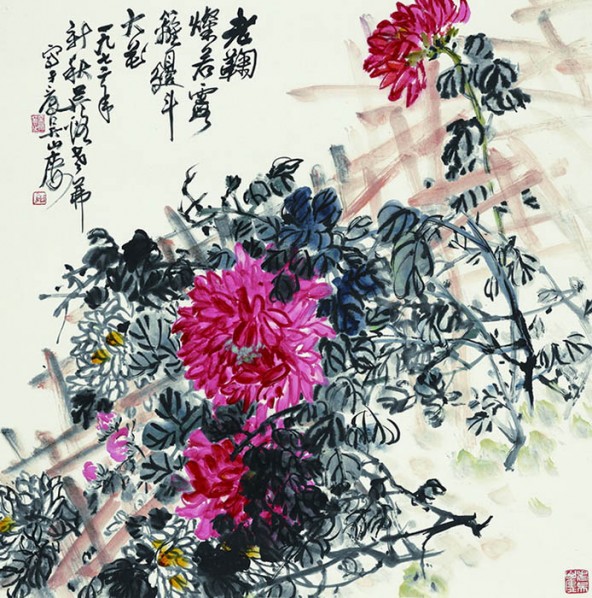
On August 23, 2013, “Elegant Flowers” Wu Fuzhi Art Exhibition opened at Zhejiang Art Museum. The exhibition features about 200 works by Wu Fuzhi, as well as a large number of valuable items of literature, the largest of all Wu Fuzhi’s exhibitions by far. To give the audience a better understanding of Wu Fuzhi’s art, important art stages of Wu Fuzhi were combed through and presented in the first part of the exhibition, a comprehensive review of Wu Fuzhi’s art history, through the introduction and interpretation of the key works, there is a showcase of the superb art ideas and remarkable artistic achievements of Wu Fuzhi. Since 2012, Zhejiang Art Museum has collected 61 works, 32 collections, 24 seals, more than 560 sheets (pages) of literature including sketches, drafts, poems, etc., which makes Zhejiang Art Museum the most important institute to collect and research Wu Fuzhi.
About artist Wu Fuzhi
Wu Fuzhi (1900-1977) was born in Qianwu Village, Pujiang County, Zhejiang Province, initially named Shiyuan, his style name was Fuzhi, which was generally used, later renamed Xi, known as Wu Xizi. In 1922, he was admitted to Shanghai Art School, benefitting from the freehand painting school of Wu Changshuo, Wang Yiting. He taught in Suzhou No.1 Normal School and Huai’an High School after his graduation in 1922. “Fuzhi Drawing” was published in 1928, and was encouraged by Liu Haisu who gave him an inscription “Detached, Leisurely, Elegant, Masterly”. In 1929, he went back to teach in Shanghai Art School, and served as an art director of Lujiang University and the affiliated School of the University. In 1932, Wu Fuzhi together with Pan Tianshou, Zhu Wenyun, Zhang Shuqi, Zhang Zhenduo founded “White Society”, inherited the spirit of innovation, committed to research and promotion of the art of Chinese painting. He had served as a Professor of Shanghai Art School, Professor and Teaching Director of the National Art School, Professor and Dean of the Department of Chinese Painting, Zhejiang Academy of Fine Arts since the Founding of new China.
Wu Fuzhi was one of the masters of modern Chinese Painting. He specialized in freehand flowers and birds, developing paintings of landscape, figures and animals, known as “Three Excellences” of poetry, calligraphy, and Chinese painting. He had a deep and sincere feeling for Chinese painting, hard work and dedication, and was unique, in the long term with artistic practice and exploring the theory. He had always pursued the philosophical dimension and spiritual realm implied by Chinese calligraphy and painting, advocating the style of literati painting containing good morals and taste, accomplishment and style, as with the context of the literati painting of the 20th century which is clearly glimpsed in his work. In addition, he was an excellent art educator, together with Huang Binhong, Pan Tianshou, and Zhu Le who established a teaching system of Chinese painting for modern academies, fostering a talented artists of Chinese calligraphy and painting, making a remarkable contribution to modern Chinese art education.
[gallery link="file" ids="30914,30915,30916,30917,30918,30919,30920,30921,30922,30923,30924,30925,30926,30927,30928,30929,30930"]
About the exhibition
Duration: August 23 – September 10th, 2013
Venue: Hall 7, 8, 9, 10, Zhejiang Art Museum
Hosters: China Academy of Art, Zhejiang Art Museum, Pujiang County People's Government
Organizers: Department of Chinese Painting, China Academy of Art, Wu Fuzhi Memorial
Translated by Chen Peihua and edited by Sue/CAFA ART INFO




























